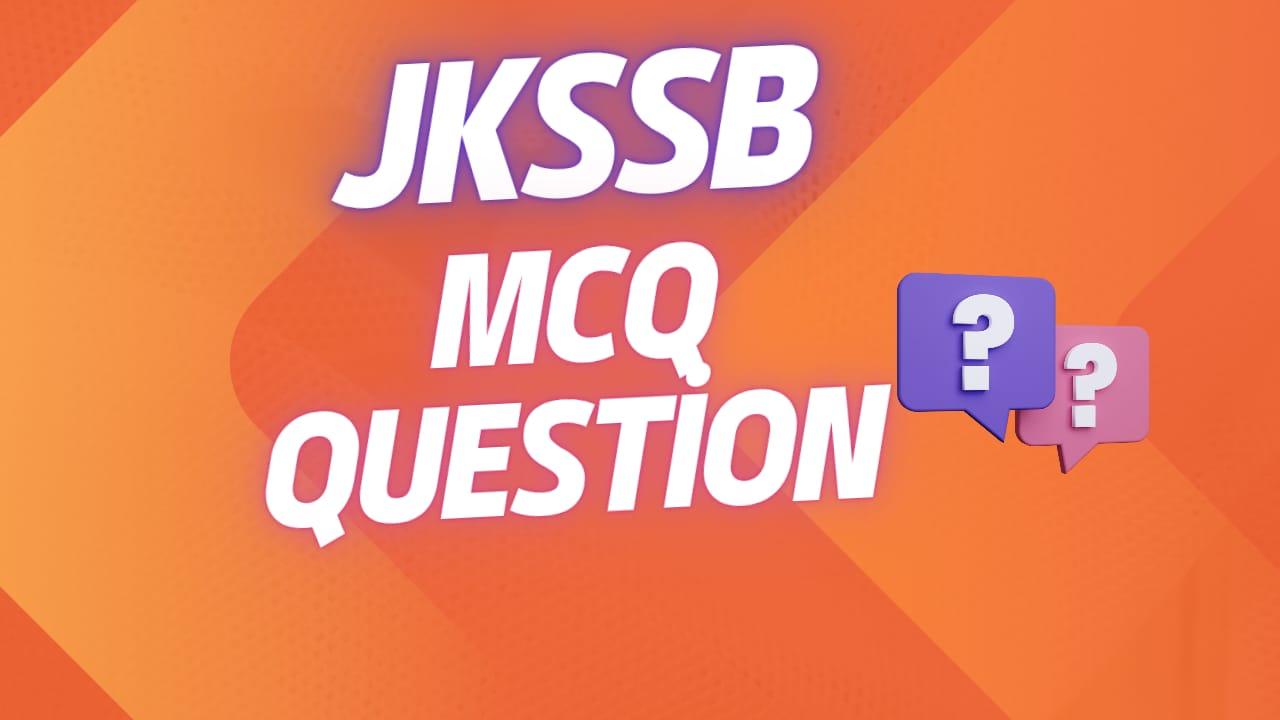JKSSB Practice QUIZ SET 1

The Longest River in Jammu and Kashmir
Jammu and Kashmir, known for its breathtaking landscapes, is home to several rivers originating from the Himalayan region. Among them, the Chenab River is the longest. The Chenab originates from the Baralacha Pass in Himachal Pradesh and flows through the Jammu region before entering Pakistan. It is formed by the confluence of two smaller streams, Chandra and Bhaga, in the Lahaul Valley of Himachal Pradesh. The Chenab is a crucial water source and plays a significant role in the region’s agriculture and hydroelectric power generation.
Who Was the Founder of the Mughal Empire in India?
The Mughal Empire, one of the most powerful dynasties in Indian history, was founded by Babur in 1526 after his victory in the First Battle of Panipat against the Delhi Sultanate’s last ruler, Ibrahim Lodi. Babur was a descendant of Timur (from his father’s side) and Genghis Khan (from his mother’s side). His conquest marked the beginning of Mughal rule in India, which lasted for over three centuries. Babur’s military prowess, strategic alliances, and effective governance laid the foundation for a strong empire that flourished under his successors, notably Akbar, Jahangir, and Shah Jahan.
Who is Known as the “Father of the Indian Constitution”?
Dr. Bhimrao Ramji Ambedkar (B.R. Ambedkar) is known as the “Father of the Indian Constitution” for his pivotal role in drafting India’s supreme law. As the Chairman of the Drafting Committee, he played a key role in shaping the Constitution of India, ensuring it provided for democracy, social justice, and equality. His work focused on abolishing untouchability, ensuring fundamental rights for all citizens, and establishing a legal framework for India’s governance. The Indian Constitution was adopted on November 26, 1949, and came into effect on January 26, 1950.
The First Battle of Panipat Was Fought in Which Year?
The First Battle of Panipat was fought on April 21, 1526, between Babur and Ibrahim Lodi, the last Sultan of the Delhi Sultanate. This battle was a turning point in Indian history as it marked the beginning of the Mughal era. Babur’s use of superior military tactics, including gunpowder, artillery, and flanking strategies, led to his decisive victory over Lodi’s larger but less organized army. This battle introduced modern warfare techniques in India, setting the stage for the expansion of Mughal rule across the subcontinent.
The Famous Amarnath Cave is Located in Which District of Jammu and Kashmir?
The Amarnath Cave, one of the holiest Hindu pilgrimage sites, is located in the Anantnag district of Jammu and Kashmir. Situated at an altitude of 3,888 meters (12,756 feet) in the Himalayas, the cave houses a naturally occurring Shivling made of ice, which is believed to wax and wane with the moon’s cycles. The cave is accessible through two main routes—via Pahalgam and Baltal—with thousands of devotees undertaking the challenging Amarnath Yatra every year. The pilgrimage holds deep religious significance, as it is believed that Lord Shiva revealed the secret of immortality (Amar Katha) to Goddess Parvati at this site.
The Indian National Congress Was Founded in Which Year?
The Indian National Congress (INC) was founded in the year 1885 by Allan Octavian Hume, a retired British civil servant, along with Indian leaders like Dadabhai Naoroji and Dinshaw Wacha. The first session of the INC was held in Bombay (Mumbai), presided over by Womesh Chunder Bonnerjee. Initially, the Congress aimed at securing administrative reforms from the British, but over the years, it evolved into the leading force in India’s struggle for independence. Under leaders like Mahatma Gandhi, Jawaharlal Nehru, and Sardar Patel, the INC played a crucial role in achieving India’s freedom in 1947.
What is the Full Form of GDP?
The full form of GDP is Gross Domestic Product. It represents the total value of goods and services produced within a country’s borders in a given time period (usually a year or a quarter). GDP is a key economic indicator used to assess a nation’s economic health. It is categorized into three types:
- Nominal GDP – Measured at current market prices.
- Real GDP – Adjusted for inflation.
- Per Capita GDP – GDP divided by the total population, indicating average economic output per person. India’s GDP is influenced by major sectors such as agriculture, industry, and services.
Who Among the Following Was the Last Ruler of the Sikh Empire in Jammu and Kashmir?
The last ruler of the Sikh Empire in Jammu and Kashmir was Maharaja Gulab Singh. He was originally a general in the Sikh army under Maharaja Ranjit Singh. Following the First Anglo-Sikh War (1845-1846), Gulab Singh signed the Treaty of Amritsar (1846) with the British, under which he purchased the region of Jammu and Kashmir for 7.5 million rupees. He then established the Dogra dynasty, which ruled Jammu and Kashmir until 1947. His rule laid the foundation for the princely state, which later became part of India after the partition.
The First President of Independent India Was?
The first President of independent India was Dr. Rajendra Prasad. He served as India’s first Head of State from 1950 to 1962, making him the longest-serving President in Indian history. Dr. Prasad played a significant role in India’s freedom struggle and was a close associate of Mahatma Gandhi. Before becoming President, he was a key leader in the Indian National Congress and served as the President of the Constituent Assembly, which was responsible for drafting the Indian Constitution. As President, he worked towards nation-building, education, and upholding the values of democracy.
Conclusion
These questions cover crucial topics in history, geography, politics, and economics, making them highly relevant for competitive exams like JKSSB, UPSC, and SSC. Knowing these facts not only helps in examinations but also in understanding the rich history and governance of India.